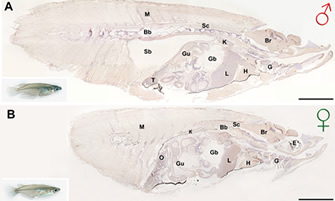Centre for Marine Environmental Research and Innovative Technology
The University of Hong Kong Pokfulam Road, Hong Kong
T +852 2299 0600
F +852 2559 9114
aoemerit@hku.hk
www.hku.hk/merit
Technology
Innovative solutions for marine protection
Chemical Detection Technologies
Early detection of environmental change is vital for protecting public and ecosystem health. Measuring levels of toxic chemicals in the environment is often difficult, however, because of the high diversity, and frequently low or highly fluctuating concentrations of these chemicals in the marine environment. As such, most existing analytical methods for measuring marine water quality are tedious, time consuming and not cost-effective.
Responding to the imminent need for rapid, reliable and cost-effective ways to measure and monitor toxic chemicals in the marine environment, MERIT strives to develop practical and innovative technological solutions.
Biological Detection Techniques
MERIT sees the vast potential of using existing biological organisms to help us measure the quality of our marine environment. In particular, we have been investigating the use of molecular, cytological and biochemical responses (biomarkers) of fish and mussels for early detection and on site measurements of hypoxia, priority pollutants and algal toxins. We have developed a small marine fish, the Marine Medaka, as a universal model for pollution monitoring and toxicological studies. By examining the molecular and biochemical responses in different tissues of Marine Medaka, we are able to quantify the level of hypoxia and pollutants in the marine environment. Further, we have developed a 'transgenic' Marine Medaka, which emits Green Fluorescent light to detect Endocrine-Disrupting Chemicals (EDCs), and Marine Medaka microarrays to quantify toxic chemicals.

Artificial Mussels
In the past three decades, biological monitors such as barnacles and mussels have frequently been used to measure metal contaminants in marine waters. However, differences in biological and environmental conditions can often lead to unreliable results, and limited natural distribution of different species also prevents direct comparisons over large areas.
To resolve this issue, MERIT has successfully developed a novel chemical measuring device, called the 'Artificial Mussel'. The device consists of a polymer ligand suspended in artificial seawater within a Perspex tube, and enclosed with semi-permeable gel at both ends. This Artificial Mussel behaves similarly to real mussels when exposed to a range of metals, but offers more consistent and reliable results by overcoming all the problems associated with biological monitors mentioned above. This represents a truly groundbreaking advance in metal detection and monitoring, and for the first time, allows global comparison of metal concentrations. With partners from eight countries all over the world, a global 'Artificial Mussel Watch' programme has been lauched.

Biosensors
Coupled with solid phase microextraction (SPME) and molecular imprinting technology, MERIT has successfully developed techniques to measure levels of red tide toxins (domoic acid and saxitoxin), and organic contaminants such as atrazine, dioxins and parathion at trace, environmental levels. MERIT is further developing a piezo-quartz crystal sensing biosensor for on site detection of other important contaminants, technology which is at the forefront of pollutant analysis. There is great potential for such devices to be adopted globally as cost-effective and reliable tools to better monitor these important chemicals in the marine environment.